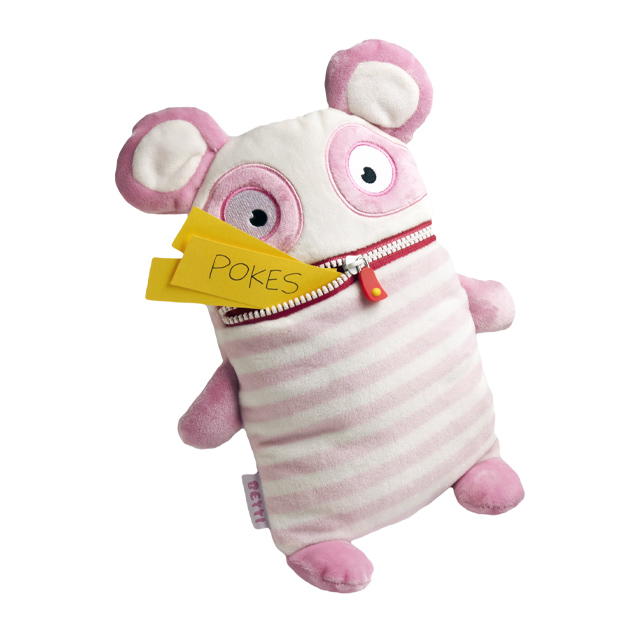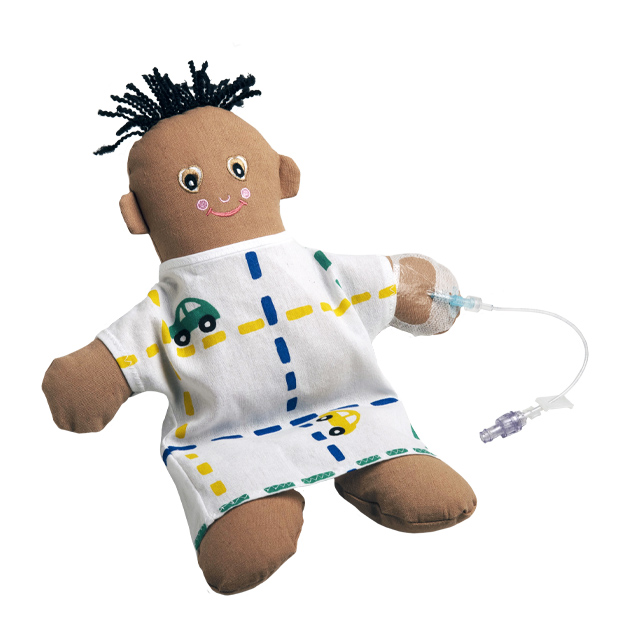Julia Alexander was 8 when a brain tumor upended her young life, along with the lives of her devoted parents, Melissa and Joe. Her old routine of ballet classes and performances, piano lessons and recitals, and school (where she was a stellar student) gave way to a new reality of hospitalizations, seemingly endless medical procedures, physical and occupational therapy, trouble keeping her balance, and even for a while struggling to remember things like her multiplication tables.
“She was scared, and there were some tears when she was in a lot of pain, but she’s a tough cookie,” says her mother, Melissa Alexander, who teaches high school English near their home in northern Virginia. And Julia’s natural resilience has blossomed under the care of her parents, her medical team at the Johns Hopkins Children’s Center and the Children’s Center’s child life specialists — a little-known cadre of professionals whose work with young patients is vital to preventing trauma that children can experience as a result of hospitalization and other medical interventions.
“Child life specialists make life in the hospital bearable for children,” Melissa Alexander says. “They bring the fun back into their lives.”

Child life specialists use the “worry eater” doll, alongside The Huge Bag of Worries book (see cover), to help children identify, sort through, and gain control over their worries and fears in the hospital, including getting shots (pokes).
Recognizing Emotional Needs
Once known as “play ladies,” child life specialists have worked in hospitals and other health care settings since at least the 1920s, according to the national Association of Child Life Professionals (ACLP). But the term play ladies belies the seriousness of their role. It is now widely recognized that children are uniquely vulnerable to long-term mental health challenges, from developmental delays to post-traumatic stress disorder, when they undergo difficult medical experiences. And it has been well-documented — the ACLP produced an extensive report, “The Value of Child Life Specialists” (2020) — that those impacts can be mitigated by child life interventions.
“Since the 1950s and 1960s, we have learned so much about child development and children’s unique emotional needs in the health care setting,” says Patrice Brylske, director of child life services at the Children’s Center, who has been a child life specialist since 1986. “And we know so much more today about the relationship between a child’s emotional state and their physical response to treatment — from pain management to how quickly and well they recover after surgery.”
Today, Brylske oversees a staff of some 25 child life specialists, who are integrated with the medical teams in every area of the Children’s Center, from oncology and the Emergency Department to cardiology and dialysis. They have all been through a rigorous training and certification process, and all have advanced degrees relevant to child life and child development. Their programs and facilities include playrooms, a teen room, a library, craft supply closets, birthday parties and other special events, visiting clowns, and a wide range of interactive television programs — the most popular are Hospital Bingo and a medical trivia contest — which they create and air on the hospital’s closed-circuit TV system.
What has been constant over the years, says Brylske, is a child’s need to play. The importance of play is not just that it makes children more comfortable. It is also a window into what they are experiencing and what they need emotionally. Child life professionals are trained to recognize those emotional needs and intervene to meet them.
“Any child with a chronic illness is going to experience psychosocial impacts,” says Melissa Alexander. “A good child life program, like the one at Johns Hopkins, makes all the difference in mitigating that impact. And it helps lift some of the burden for parents. Julia’s first hospitalization was just before Christmas and she was in tears, so afraid Santa wouldn’t find her. Instantly, there was a child life specialist there with a letter from Santa letting her know he would find her wherever she was.”
Julia, who is now 15, has made a lot of friends over the years among her caregivers at the Children’s Center. But there is no one she loves more than Mollie Young, who has spent the last decade as a child life specialist in pediatric radiology.
“Miss Mollie is kind, smart, beautiful and almost perfect,” Julia says. “Miss Mollie and her friends helped me get a new love for life.”
Young’s job is to prepare and shepherd children and their families through imaging procedures that are challenging even for adults. Some scans require IVs and/or catheters, and some MRI scans require children to lie completely still inside a noisy and cavernous machine for more than an hour.
From the beginning, the thing Julia hated most about getting an MRI scan was the IV inserted into her arm to inject dye that helps produce a better image. “I will do anything to avoid the evil needle,” she says.
It’s not uncommon for children (and even some adults) to hate needles and to dread being confined for an MRI scan, so Young encourages all of her patients to discuss their fears and come up with their own coping techniques. One patient might choose to squeeze stress balls to help him keep still during a long MRI scan. Another patient who loves to cook created her own “recipe” book, which included strategies like deep breathing and listening to soothing music, to get through a hated procedure.
“We want children to feel empowered and to participate in their care,” Young says. “Each time they get through a scary procedure using coping skills they’ve chosen, it prepares them for future challenges. It’s not just about one MRI. It’s about the rest of their lives.”
Young, who earned her master’s degree in public health last year at Johns Hopkins’ Bloomberg School of Public Health, has helped the Pediatric Radiology Division dramatically increase its use of child life-assisted MRIs — innovative work that was described in a Johns Hopkins study she co-authored published in the Journal of the American College of Radiology. For years, most pediatric radiology departments required general anesthesia for young children undergoing MRI scans because they have trouble keeping still. The Johns Hopkins team has shown that instituting a mandatory child life evaluation for patients ages 5 to 18 undergoing MRI scans enables many children to forgo general anesthesia.
Young consults with families ahead of time to determine if their child is a likely candidate for forgoing anesthesia, then coaches those children through the process. The division has had a more than 90 percent success rate — with “success” defined as producing great, clear images with minimal distress to the child. Young jumped in to step up the practice during COVID-19, when anesthesiologists were unavailable for elective procedures. Child life-assisted MRIs not only use fewer resources, including time — they help children avoid the risks and potential side effects of general anesthesia.
Good child life specialists are always adapting, Young says. “Every child is different, and we have to be open-minded, to think on our feet.” In the early years of her treatment, Julia had to have scans as often as once a month, and Young was not only there to hold her hand, she helped the Alexanders come up with multiple ways to reduce Julia’s stress in advance.
“Mollie advised us to get a prescription for something to help Julia relax, and she found her this one nurse, who is now retired, who is just a genius at getting the needle in easily,” Melissa Alexander says.
But Young also discovered that Julia loves to sing — she has a clear, bell-like voice — and it has become Julia’s routine to sing her favorite song, an inspirational hymn she learned in kindergarten called “Do Everything Without Complaining,” every time she is poked with a needle.
“Julia has always been able to pull on her inner strength and just channel it,” says Young. “When she comes in, I always have craft materials ready for her because she likes to make inspirational signs for the other kids to see, including ‘Strong Is the New Sparkle,’ which is just so creative and so perfect.”

“We use dolls like this one to teach children about medical procedures, like the IV seen here, to help them prepare for and gain mastery over their own healthcare experiences,” says Young.
‘Strong Is the New Sparkle’
At the Johns Hopkins Children’s Center, child life specialists are fully integrated into their particular department’s medical team, and Young says an important part of her job is to make sure the handoff to another child life specialist is smooth when a patient like Julia goes from one department in the hospital to another. “Good communication is vital,” she says.
Child life specialists do bereavement counseling with the families of dying children and with children who have lost a parent. They use puppets to explain life-changing diagnoses like diabetes to young children and dolls that allow children to play at rehearsing an upcoming medical procedure. At the start of the COVID-19 pandemic, Brylske’s team quickly created coloring books and other materials to teach children and their families about tests, vaccines, personal protective equipment and the isolation units that went up in the hospital overnight. “And because we had to close our playrooms, which rely heavily on volunteers, we doubled our number of live interactive TV shows, made up new things and tried new stuff, so every child could join the virtual playground of TV and interact with a live person who actually talked to them,” Brylske says.
Through their professional advocacy, child life specialists were pioneers in the family-centered care movement, which advocates for frequent family visits and parental participation in the care of sick children. They work closely with parents and siblings, who are often themselves traumatized by the medical event. Brylske talks about teaching even parents of newborns how to hold and comfort their babies while they are being poked or prodded and how to distract little ones from their pain, including with something as simple as blowing bubbles.
“Parents play a vital role,” says Young, “and Julia’s parents and I all worked really hard together from the beginning to build a foundation. So even though it is still stressful for her, Julia knows what to expect — from making her signs, to knowing her Dad is going to be in the room with her, to us talking and singing through the IV. I really think she is exceptionally strong at coping today because of all we established when she was younger.”
And Young says it’s clear that Julia — who is their only child — derives great strength from her parents. Together, the family participates in runs, radiothons and other efforts to raise money specifically for Johns Hopkins’ child life department. Child life depends heavily on philanthropy to fund salaries and programs, Brylske says. And Julia, her mother, Melissa, and her father, Joe (a West Point grad who is in leadership at the U.S. Army Research Lab), have on more than one occasion donned matching tutus and T-shirts sporting Julia’s favorite slogans, including “Strong Is the New Sparkle,” to support these fundraising events.
“We started raising money to support pediatric brain cancer research,” Melissa Alexander says, “but we also want to do our part to make sure kids are loved while they are in medical crisis, to get their emotional needs met so they can really begin to heal.”
